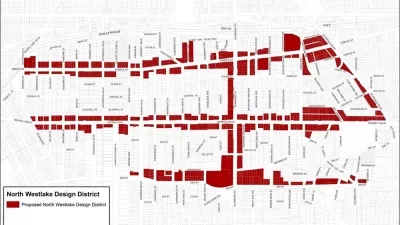An in-depth study of business improvement districts (BIDs) in two Los Angeles neighborhoods examines the factors behind their success or failure.

Oscar Perry Abello shares news of a comparison study published in the Urban Affairs Review journal, by SUNY Albany Assistant Professor Wonhyung Lee.
While BIDs are usually conceived as purely commercial entities, according to Abello's description of the study, "BIDs in smaller neighborhoods can serve as a pathway for more comprehensive community development."
Lee writes, "Strong community organizing by other institutions, like churches or neighbors associations, can lead to successful formation of a BID, which then becomes a vehicle for brokering productive relationships between otherwise disparate populations united by the common cause of neighborhood business growth."
Lee's research compared BIDs in two multiethnic L.A. neighborhoods: the Byzantine-Latino Quarter and MacArthur Park. The first succeeded while the second foundered. Lee identifies three primary factors behind the Byzantine-Latino Quarter's success: 1) strong, entrenched leadership, 2) organizational resources and connections, and 3) a positive atmosphere around diversity and ethnicity.
FULL STORY: Community Organizing Powers BIDs in Multiethnic Neighborhoods

Planetizen Federal Action Tracker
A weekly monitor of how Trump’s orders and actions are impacting planners and planning in America.

Congressman Proposes Bill to Rename DC Metro “Trump Train”
The Make Autorail Great Again Act would withhold federal funding to the system until the Washington Metropolitan Area Transit Authority (WMATA), rebrands as the Washington Metropolitan Authority for Greater Access (WMAGA).

DARTSpace Platform Streamlines Dallas TOD Application Process
The Dallas transit agency hopes a shorter permitting timeline will boost transit-oriented development around rail stations.

Renters Now Outnumber Homeowners in Over 200 US Suburbs
High housing costs in city centers and the new-found flexibility offered by remote work are pushing more renters to suburban areas.

The Tiny, Adorable $7,000 Car Turning Japan Onto EVs
The single seat Mibot charges from a regular plug as quickly as an iPad, and is about half the price of an average EV.

Supreme Court Ruling in Pipeline Case Guts Federal Environmental Law
The decision limits the scope of a federal law that mandates extensive environmental impact reviews of energy, infrastructure, and transportation projects.
Urban Design for Planners 1: Software Tools
This six-course series explores essential urban design concepts using open source software and equips planners with the tools they need to participate fully in the urban design process.
Planning for Universal Design
Learn the tools for implementing Universal Design in planning regulations.
Municipality of Princeton
Roanoke Valley-Alleghany Regional Commission
City of Mt Shasta
City of Camden Redevelopment Agency
City of Astoria
Transportation Research & Education Center (TREC) at Portland State University
US High Speed Rail Association
City of Camden Redevelopment Agency
Municipality of Princeton (NJ)



























